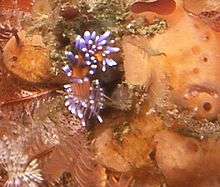Trinchesia speciosa
Trinchesia speciosa, common name the "candy nudibranch", is a species of sea slug, an aeolid nudibranch, a marine gastropod mollusc in the family Trinchesiidae.[2]
| Trinchesia speciosa | |
|---|---|
 | |
| The lilac colour form of Trinchesia speciosa. Vulcan Rock, Cape Peninsula, South Africa | |
| Scientific classification | |
| Kingdom: | Animalia |
| Phylum: | Mollusca |
| Class: | Gastropoda |
| Subclass: | Heterobranchia |
| Order: | Nudibranchia |
| Infraorder: | Cladobranchia |
| Superfamily: | Fionoidea |
| Family: | Trinchesiidae |
| Genus: | Trinchesia |
| Species: | T. speciosa |
| Binomial name | |
| Trinchesia speciosa | |
| Synonyms | |
| |
Distribution
This species was described from two specimens, one found in a rock pool one mile south of Kalk Bay harbour and the other amongst barnacles at Dalebrook, both in False Bay, South Africa. The candy nudibranch is endemic to South Africa. It is found from the Atlantic coast of the Cape Peninsula to Port Elizabeth, intertidally to at least 30 m.[3]
Description
The candy nudibranch is a vividly coloured nudibranch, having a yellow-orange body and turquoise or purple cerata with yellow tips. It grows to 20 mm in length. The rhinophores are smooth and usually also yellow-orange, although they make take on the colours of the cerata. Three distinct colour forms exist, two with blue cerata and yellow to orange rhinophores and another form with lilac cerata and lilac coloured rhinophores and oral tentacles. The colour form or similar species with iridescent blue cerata was identified as Cuthona ornata by Gosliner[3] and as Cuthona speciosa by Rudman, 2002.[4]
Ecology
The candy nudibranch eats hydroids of the genus Sertularella.[3] In common with other aeolid nudibranchs, the cerata of the candy nudibranch aid in respiration but also contain extensions of the digestive system. The candy nudibranch eats the hydroid and passes its nematocysts unharmed through its digestive system to the tips of its cerata. Here the nematocysts mature and are then used by the nudibranch for its own defence. It is probable that the bright colours of the candy nudibranch serve to advertise to predators that it is toxic.
Candy nudibranchs are hermaphrodites. Their egg mass is a spiral collar of orange eggs.[5]
References
- MacNae, William. 1954. On some eolidacean nudibranchiate molluscs from South Africa. Annals of the Natal Museum 13(1):1-50, pls. 1-2.
- Rosenberg, G. (2014). Cuthona speciosa (Macnae, 1954). Accessed through: World Register of Marine Species on 2015-03-02.
- Gosliner, T.M. (1987). Nudibranchs of Southern Africa ISBN 0-930118-13-8
- Rudman, W.B. (2002) (July 24) Cuthona speciosa (Macnae, 1954). [In] Sea Slug Forum. Australian Museum, Sydney.
- Zsilavecz, G. (2007). Nudibranchs of the Cape Peninsula and False Bay ISBN 0-620-38054-3
| Wikimedia Commons has media related to Trinchesia speciosa. |